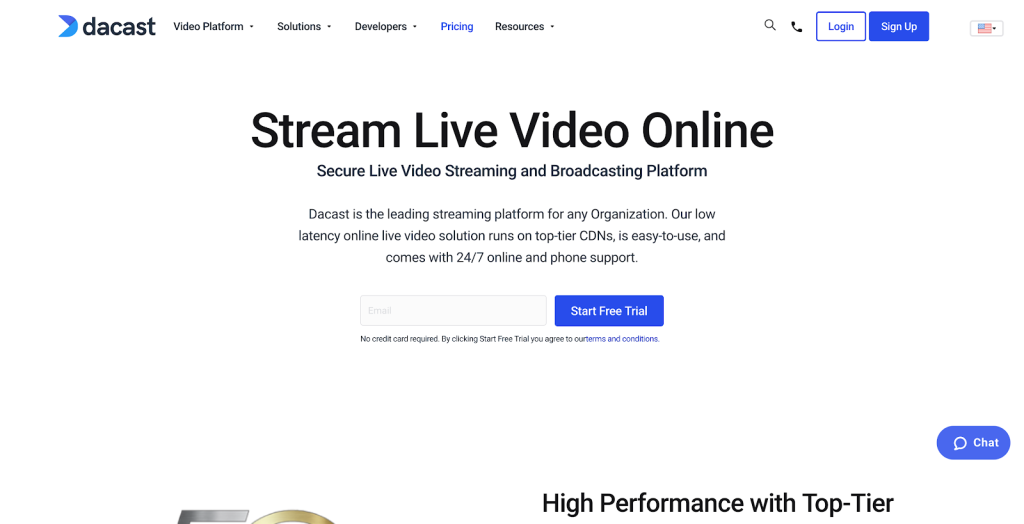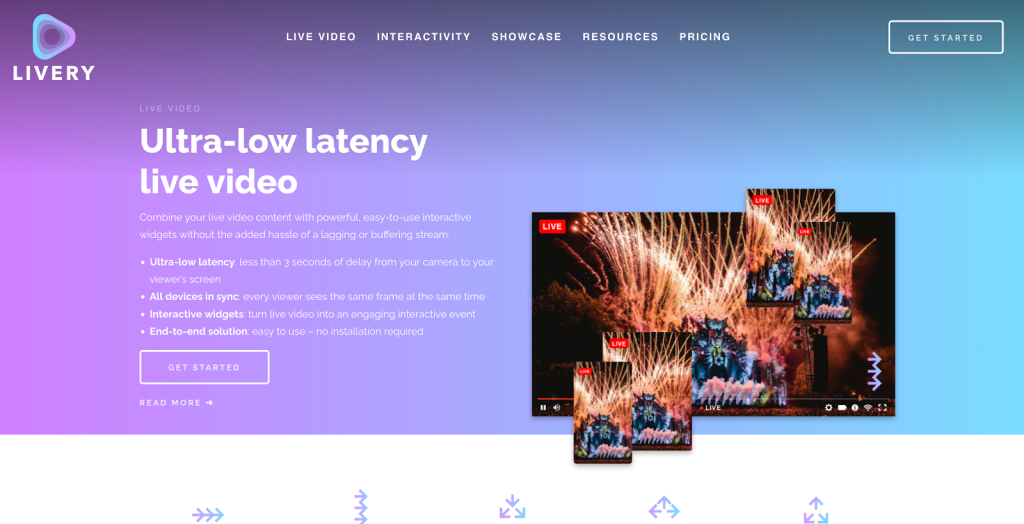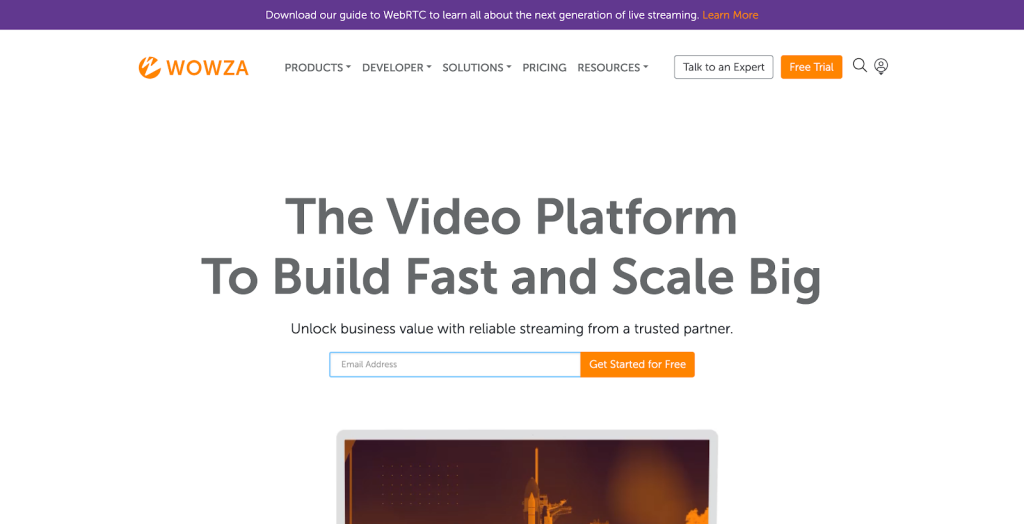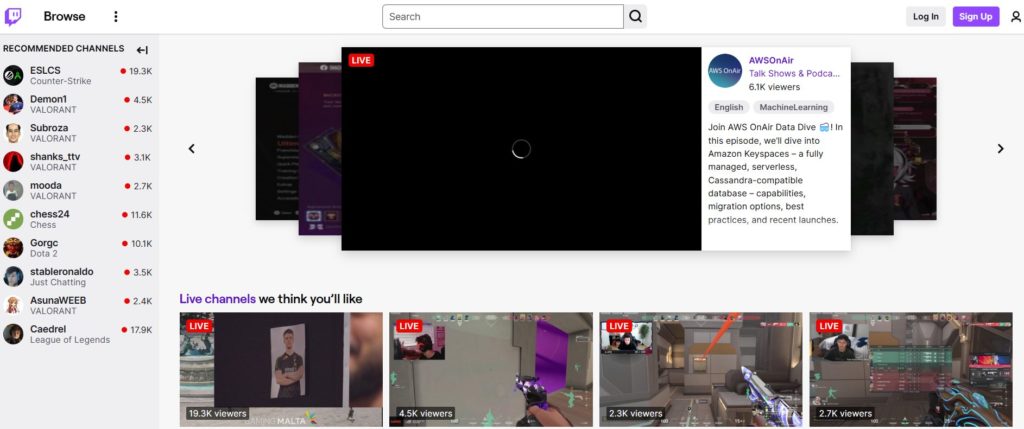Talking about the Future of Live Streaming with Ultra-Low Latency Solutions
Nobody wants slow, stuttering, lagging video streaming – especially in this day and age. On the contrary, everyone wants a fast, smooth, and perfectly synced video streaming experience. The difference between having constant buffering issues and buttery smooth video streaming comes down to one word: latency.
Online video streaming, whether it be live streaming, OTT video streaming or online education, has become increasingly common. As a result, having ultra-low latency streaming is evermore vital. Research shows the global average time spent watching videos online daily is 84 minutes. This global average accounts for all types of video content across all ages. In some countries and age groups, such as millennials, up to a massive 10-20 hours of video is consumed each day.
With so much video consumption, ultra-low latency video streaming is becoming the new normal. If you live stream or produce video streams of any sort, you need ultra-low video latency to keep your viewers worldwide tuning in. Read on and discover the benefits of ultra-low latency, how to implement it, and the best solutions for achieving it.
Table of Contents
- What is Ultra Low Latency Video Streaming?
- Why is Low Latency Streaming Important?
- 2025 Trends in Ultra-Low Latency
- The Benefits of Achieving Ultra-Low Latency Streaming
- Use Cases for Ultra-Low Latency Streaming
- Key Technologies and Tools Powering Ultra-Low Latency Streaming
- Comparison of Low-Latency and Ultra-Low-Latency Streaming Protocols
- How to Achieve Ultra-Low Latency Streaming
- Top 10 Best Solutions for Achieving Ultra-Low Latency Video Streaming
- Developer-Focused Insights
- Latency Optimization Checklist
- FAQs
- Conclusion
- Achieve Ultra-Low Latency Streaming With Dacast
What is Ultra Low Latency Video Streaming?

Before diving into ultra-low latency video streaming, it’s important to understand latency itself. In streaming, latency is the delay between sending and receiving video content. The lower the latency, the closer to real-time the experience.
High latency can cause sync issues, especially in live events, video calls, or broadcasts. This often leads to a poor viewer experience and, for businesses, potential revenue loss.
While low latency is good, ultra-low latency is even better. A good low latency is generally considered 15 seconds or less. Ultra-low latency video streaming is sub-second latency video streaming. That’s less than a one-second delay. The result is seamless, perfectly synced video playback on the viewer’s end.
Why is Low Latency Streaming Important?

Low-latency streaming is imperative today. With the internet’s ubiquity and live streaming worldwide, people expect video streaming without delay.
Viewers with an unpleasant viewing experience because of latency issues are more likely to stop engaging. For businesses, this can prove dire. Providing high-performance video streaming through a low-latency streaming service is important. It can mean the difference between retaining and gaining viewers instead of losing them. As a streamer, you should aim to reduce latency and provide a better viewer experience for your viewers and customers.
The Negative Impact of High Latency Video Streaming
Video streaming latency that’s too high has direct negative consequences on the viewers’ experience. This is especially true when real-time video streaming is needed for properly synced and enjoyable video playback.
High-latency video streaming can cause low video quality that stops and starts. This leads to unsatisfactory video-watching experiences for viewers that can even become unwatchable.
What causes high latency?
Several distinct factors cause high latency. These factors in and of themselves can cause major issues. But one is often interwoven with another, causing even more delay.
Here are some of the most common issues that cause high latency:
- Poor internet connection: A poor internet connection is one of the most common issues for latency, which leaves much to be desired. A slow or unstable connection with little bandwidth can cause the buffering and stuttering issues we’ve all experienced. Nowadays, video quality is higher than ever, and many devices simultaneously connect to the internet. Providing a fast and stable internet connection is more important than ever.
- Low-quality hardware: Having low-quality hardware is another common reason for high latency. A video camera, encoder, decoder, or other components that aren’t up to the job can lead to latency issues. Hardware that isn’t powerful enough is particularly problematic in real-time video streaming.
- Distance: The beauty of the internet is that it connects the world. However, the reality of physics means that the farther the distance between the video source and the audience, the higher the latency. Streaming video, especially live streaming video, across countries and continents can cause a delay.
- Weak encoding process: The encoding process compresses the video data so the video signals can be sent more efficiently over the internet. Having a weak encoder process results in slower performance. The final product is increased latency and lower video quality.
- Streaming protocol problems: A streaming protocol is a set of rules responsible for how video is streamed. This video streaming technology is designed to be flexible and efficient without compromising on video quality. However, if the protocol isn’t optimized for dynamic adaptive streaming, it can cause a delay in video streaming and latency.
2025 Trends in Ultra-Low Latency
AI-powered adaptive bitrate streaming (ABR)
In 2025, AI is playing a bigger role in managing ultra-low latency streaming. Smart adaptive bitrate streaming uses real-time data to adjust video quality instantly, keeping streams smooth even when network conditions change. This helps reduce live video latency while ensuring viewers see content without buffering. It’s a smart step toward achieving low latency video and control without sacrificing quality.
Edge computing and multi-access edge networks (MEC)
Edge computing and MEC are helping real-time video delivery happen closer to viewers. By processing data near the source, these technologies reduce the distance video must travel, cutting down on lag. For anyone exploring how to reduce video streaming latency in real time, this is a key part of an ultra-low latency streaming solution.
5G and 6G rollout impact
With 5G becoming widespread and 6G on the horizon, ultra-low latency internet is more accessible than ever. These networks offer faster, more stable connections that support sub-second latency and ultra-low latency video. This matters for low latency live streaming, especially for interactive content like auctions or gaming.
Cloud-native video infrastructure
Cloud-native video systems are becoming essential to ultra-low latency platforms. Built for flexibility, they let broadcasters scale easily and deploy low latency streaming services worldwide. Whether comparing platforms or looking for the lowest latency streaming service, cloud-native architecture plays a big role in modern low latency streaming solutions.
The Benefits of Achieving Ultra-Low Latency Streaming

Ultra-low latency streaming is becoming the new norm as increasing numbers of viewers worldwide watch video online. An ultra-low latency streaming solution is the pinnacle of great video streaming for viewers. Fast, efficient, and reliable video streaming with sub-second delay possesses many benefits that keep people tuning in.
Some of the benefits of ultra-low latency video streaming include:
- Better synchronization of live events.
- Less buffering.
- Fewer pauses.
- Less rewinding.
- Better, higher resolution video quality.
Ultra-low latency video provides viewers with an exceptional experience. More and more people watch and stream video online, with ultra-low latency becoming the new normal. It’s paramount that professionals produce the demanded seamless viewing experience.
Use Cases for Ultra-Low Latency Streaming
Ultra-low latency streaming is changing how industries deliver video in real time. In live sports and esports, sub-second latency ensures fans experience the action as it happens, without delay. For interactive webinars and virtual events, real-time video streaming with low latency creates smooth Q&A, polls, and audience interaction, which improves engagement.
In live shopping and video commerce, reducing latency helps sellers respond instantly to customer interest, boosting conversions. Real-time surveillance and drone feeds depend on low latency video streaming protocols to make fast, accurate decisions in critical situations. Financial trading platforms also use ultra-low latency streaming solutions to share time-sensitive data without lag.
These use cases show why choosing the right low latency video protocol or ultra low latency platform is key for businesses that need real-time communication.
Key Technologies and Tools Powering Ultra-Low Latency Streaming
LL-HLS vs WebRTC vs SRT: A Quick Breakdown
Choosing the right protocol for ultra-low latency streaming depends on your priorities—speed, scale, or reliability.
LL-HLS works well for large audiences using modern HTML5 video players. It offers latency around 2–5 seconds and scales easily over HTTP-based CDNs, but it’s not true real-time.
WebRTC delivers sub-second latency, making it ideal for live interactions like auctions or video calls. It’s the fastest option but harder to scale due to its complex server setup.
SRT offers strong reliability over less stable networks. With latency around 1–2 seconds, it’s great for remote feeds or contribution workflows.
A flexible ultra-low latency streaming platform, like Dacast, often supports multiple protocols to suit different use cases.
Benchmarks and Statistics
When comparing video protocols with sub-second latency, it’s helpful to look at the numbers. WebRTC typically delivers latency around 500 milliseconds, making it ideal for real-time video streaming with low latency. SRT (Secure Reliable Transport) usually runs at about 1 to 2 seconds, while LL-HLS (Low-Latency HLS) averages between 2 to 3 seconds. These benchmarks show the difference between HLS and WebRTC for live streaming, especially when the goal is to reduce delay.
Latency matters. Studies show that viewers start abandoning streams when latency goes beyond a few seconds. In fact, 40% of users will abandon a video if there’s a noticeable delay.
Real-time engagement is also key. Research highlights that over 60% of viewers prefer interactive features made possible by ultra low latency for interactive video.
End-to-End Latency: From Camera to Playback
End-to-end latency includes every step from video capture to playback. Here’s how it typically breaks down:
- Capture – Camera records the video.
- Encoding – Video is compressed.
- Packaging – Stream is formatted using LL-HLS, WebRTC, or SRT.
- Delivery – Sent over an ultra-low latency network or CDN.
- Playback – Played on the viewer’s device.
Each stage adds delay. Ultra-low latency streaming aims to keep this under 1 second. Optimization techniques like edge delivery, adaptive players, and fast, reliable ultra-low latency internet help minimize lag.
Monitoring Latency with QOE Metrics and Dashboards
Monitoring live video performance is key to reducing latency. Tools that measure Quality of Experience (QOE)—such as buffering, load times, and viewer drop-offs—help pinpoint issues.
Many ultra-low latency platforms integrate with analytics tools like Mux or New Relic, giving real-time visibility into stream health.
Dacast offers built-in metrics and observability dashboards, helping you monitor and optimize latency as your stream goes live.
Predicting and Reducing Latency with AI and Machine Learning
AI and machine learning are helping platforms manage latency more intelligently. They analyze live data—like network speed or device type—to adjust bitrate, routing, or buffer size in real time.
AI can predict network slowdowns before they impact the stream, automatically optimizing delivery. This keeps latency low without manual tuning.
Platforms like Dacast are using AI to improve stream stability and reduce delays, especially on congested or variable networks.
Comparison of Low-Latency and Ultra-Low-Latency Streaming Protocols
Here’s a handy comparison table of popular low latency and ultra-low latency video streaming protocols—WebRTC, LL-HLS, SRT, RIST, Zixi, and RTMP—based on latency, scalability, compatibility, and use cases.
| Protocol | Latency | Scalability | Compatibility | Common Use Cases |
|---|---|---|---|---|
| WebRTC | Ultra-low (0.2–0.5s) | Moderate | Modern browsers, mobile, some CDNs | Real-time interactivity, auctions, video conferencing, gaming |
| LL-HLS | Low (2–5s) | High (CDN-friendly) | Broad HTML5 support, iOS native | Sports, events, large-scale streaming with some delay |
| SRT | Low (1–2s) | High (point-to-point) | Software-based, encoder support | Remote production, contribution feeds, secure low latency delivery |
| RIST | Low (1–2s) | High (broadcast-grade) | Broadcast hardware/software | Broadcast transmission, contribution, redundancy-focused streams |
| Zixi | Low (1–2s) | High (enterprise-grade) | Zixi platform required | Enterprise OTT, secure delivery, monitored large-scale broadcasts |
| RTMP | Moderate (3–5s) | Moderate | Legacy support (Flash, OBS, etc.) | Ingest to platforms like YouTube, Facebook Live; contribution only |
Notes:
- WebRTC is the best streaming protocol for ultra-low latency, enabling sub-second, real-time video streaming low latency.
- LL-HLS is more scalable via CDNs but cannot reach sub-second levels.
- SRT, RIST, and Zixi are low latency streaming protocols often used for contribution and broadcast infrastructure, not end-user playback.
- RTMP is outdated for playback but is still used as an ingest method for many low latency streaming platforms.
How to Achieve Ultra-Low Latency Streaming

The easiest step towards achieving ultra-low latency is to deploy a new network with the next generation of programmable hardware and software. However, ultra-low latency streaming can still be achieved on existing networks.
But it’s not just the network that’s important. The hardware and software used are crucial, too. Investing in the right video streaming solution is paramount to a great viewing experience for professionals and businesses.
1. Evaluate your current network
To ensure a low-latency streaming solution, the first part of this multi-step process is to evaluate your current network. Start by following these steps:
- Identify any existing network problems and their impacts.
- If any existing problems impact your network, confirm whether or not they’re causing high latency.
- Evaluate which network switches and interface cards can be replaced so a low-latency environment can be implemented.
- Identify which network functions can be offloaded to:
- Field-programmable gate array (FPGA)-programmable switches
- Smart network interface cards (SmartNICs)
2. Take action to reduce latency
The second part is the process is taking action to reduce your latency. Here are the fundamental steps:
- Improve the network connection: The first place to begin reducing the latency of streaming video is in the network itself. You can improve your latency by increasing the bandwidth or configuring a more stable connection. More bandwidth and a more stable connection can help ensure better video streaming services.
- Use high-quality hardware: You can also reduce latency by using high-quality hardware. Several examples of high-quality hardware that can reduce latency are a more powerful camera, an ultra-low latency video encoder, and a better decoder for reduced (de)compression of video data.
- Improve the encoding process: Improving the encoding process means the raw video is better processed into more efficient data for streaming video. This makes the transmission more efficient, knocking off the time it takes to transmit.
- Use adaptive streaming protocols: You can also reduce latency by using adaptive streaming protocols such as HLS low-latency streaming solution, DASH, or WebRTC technology. A low-latency streaming protocol like this can help reduce video buffering.
- Reduce the distance: You can further improve latency by reducing the distance between the video source and viewers. This can be done through streaming video from a closer server to your viewers or using a CND for uninterrupted viewing.
Top 10 Best Solutions for Achieving Ultra-Low Latency Video Streaming
Achieving ultra-low latency for smooth and seamless video and real-time streaming is possible with the right solutions. These top three platform solutions come integrated with low-latency streaming and live streaming capabilities.
1. Dacast

Basic Functionality :
Dacast is a powerful, unified streaming solution that uses the best HLS delivery and RTMP ingest to achieve ultra-low latency streaming. Dacast’s video streaming platform includes live streaming, VOD hosting, and other professional broadcasting features.
Dacast offers low-latency streaming as standard. The ready, out-of-the-box features Dacast packs massively reduce latency. Dacast will help you achieve ultra-low latency video streaming for the highest quality.
Best Use :
Dacast is a fantastic all-around platform that provides all the features necessary to achieve ultra-low latency. Dacast’s complete solution is great for everything from live streaming to broadcasting events to online meetings. Further, with built-in monetization, state-of-the-art encoding, and scalable pricing, Dacast offers the total package to provide businesses with the tools they need to succeed and their viewers with the best video streaming possible.
Key Features :
- Monetization tools (SVOD, AVOD), and pay-per-view (TVOD)
- White label and branding control
- Adaptive bitrate streaming to allow multiple streams with varying bitrates
- RTMP Encoder for ingesting HLS streaming
- Low latency HTML5 channels for video streaming
- Live encoding support for the top video encoders
- Zoom live streaming integration
- Expo galleries video portal
- Unlimited viewers and live channels
- Video security tools for secure streaming
- Global content delivery with strategic CDN partnerships
- Multi-bitrate streaming
- Player API and Video API access
- M3U8 file creation capability to enable adaptive streaming delivery of OTT video content across various devices
- Multistreaming capabilities for simulcasting to multiple platforms at once
- 24/7 tech support
Pricing :
Dacast has multiple live streaming pricing plans. Here is a quick summary of all plans:
- Starter: $39/month billed annually (includes 2.4 TB bandwidth and 500 GB storage)
- Event: $63/month billed annually (includes 6 TB bandwidth and 250 GB storage)
- Scale: $165/month billed annually (includes 24 TB bandwidth and 2 TB storage)
- Custom: contact sales for custom pricing plans
2. Livery

Basic Functionality :
Livery offers ultra-low latency video with an easy-to-use interface and interactive widgets. The platform’s focused on providing ultra-low latency and synchronizing all devices so viewers experience the same frame rate every time. Their solution is geared toward professionals who need in-sync and responsive ultra-low latency video streaming.
Best Use :
This platform is great for professionals who need robust performance with an interactive yet seamless user experience. It comes pre-built with ultra-low latency advanced features, so live events and performances are streamed in-sync.
Key Features :
- Ultra-low latency built-in.
- Keeps all devices in sync.
- Interactive widgets.
- Scalable live streaming to reach millions.
- Easy to install.
- End-to-end solution.
Pricing :
Livery offers unique, customizable pricing options. Its tailored pricing allows for complete flexibility and scalability. Livery users only pay for what they use, with no upfront costs.
The flexible contract supports users as their needs change. Monthly invoices are calculated by the minutes used. Further, Livery only charges users for the features they use. For example, users who use live video but don’t use the interactive features will pay for the live video but not for the interactive features.
Their pricing tool takes users through a series of basic usage questions, such as the number of sessions they’ll need, the level of video quality they want, and add-ons. Once calculated, users can buy there and then contact support to ask additional questions.
3. Wowza

Basic Functionality :
Wowza is a video platform built for speed and scalability. Wowza is a live-streaming and VOD platform with a robust set of features. It is designed for developers and includes extensive customizability, an integrated video platform, and streaming server software.
Best Use :
This platform is best for developers who want to customize their solutions deeply. It has the features one might expect, such as live streaming and on-demand video hosting, but it lacks business functionality like advanced monetization features. Furthermore, Wowza emphasizes WebRTC for real-time video delivery, offering sub-second latency ideal for interactive use cases. In contrast, HLS has broader playback support but higher latency, typically 6–30 seconds, making it less suitable for real-time interaction.
Key Features :
- Allows developers to build their own solutions.
- Quick start.
- Real-time video with WebRTC.
- Live event support.
- Mobile-compatible video playback.
Pricing :
- Pay As You Go: $0 per month only pay for usage at a rate of $2.50 per streaming hour and $0.10 per viewer hour
- One Month of Streaming: $149 one-time purchase; includes 15 hours of live streaming and 500 viewing hours
- Plans built for your needs: Best for large audiences and large volume videos, but you should contact Wowza for custom pricing
All the Live Event plans reflect rates when paid monthly and include full brand control, multi-bitrate streaming, and UHD and HD streaming.
The Wowza Streaming Engine has its own professional-grade streaming plans billed annually and includes:
- Basic Monthly: $195/month with the first instance included (Additional instances $195)
- One Month Streaming: $295/month with the first instance included (Additional instances $295)
- Enterprise: Please contact Wowza directly for access to their custom-tailored high volume enterprise solutions
For more details, check out this third-party review of the platform.
4. IBM Video Streaming

Basic Functionality :
IBM Video Streaming is an enterprise-focused platform designed to deliver live and on-demand video with reliable performance, branding, and analytics.
Key Features :
- Low latency delivery (~2–5 seconds)
- Real-time viewer analytics
- Cloud transcoding and global CDN
- White-label video player and custom branding
Detailed Features :
- RTMP ingest with adaptive bitrate streaming
- Custom channel branding and embed controls
- Live event scheduling and registration tools
- SSO, password protection, and geo-restrictions
- Real-time Q&A, chat, and polling (via add-ons)
Pros :
- Enterprise-grade reliability
- Built-in security and access control
- Highly scalable infrastructure
- Strong support and SLAs for business users
Cons :
- More expensive than creator-focused platforms
- UI may feel dated compared to newer tools
- No native WebRTC support for sub-second latency
Pricing :
IBM pricing plans include the following:
- Start Trial – Video Streaming: Give it a free test drive for 30 days
- Silver: Affordable Essentials, 100 viewer hours, 5 channels, 1 TB video storage, starting at $145/month
- Gold: Standard business features, 2,000 viewer hours, 10 channels, 2 TB video storage, starting at $729/month
- Platinum: Premium Volume scale, 5,000 viewer hours, 20 channels, 5 TB video storage, starting at $1,460/month
- Custom: Please contact IBM Cloud video for custom plan pricing as well as payment plans
IBM Video Streaming also offers an SaaS streaming service with AI-driven deep search for security-rich video communications. Here are the IBM Enterprise Video Streaming pricing plans:
- Enterprise Silver: $847/month
- Enterprise Gold: $2,120/month
- Enterprise Platinum: $5,300/month
- Custom: Contact the sales team
30-day free trials are available for test-driving both the IBM Video Streaming and the IBM Enterprise Video Streaming services.
5. YouTube Live

Basic Functionality :
YouTube Live lets users stream video in real time to global audiences using Google’s CDN infrastructure.
Key Features :
- Ultra-low latency mode (2–5 seconds)
- Live chat and audience interaction
- Auto-archiving of streams
- Seamless integration with Google accounts
Detailed Features:
- RTMP ingest and adaptive playback
- Scheduled or spontaneous streams
- DVR-style rewind and playback
- Integration with YouTube Studio
Pros :
- Free to use
- Massive global reach
- Easy to start with basic equipment
- Built-in audience growth tools
Cons :
- Limited control over monetization
- No WebRTC support
- Not ideal for private or white-label use
Pricing :
- Free with a Google account
- Monetization via ads, memberships, and donations
6. Facebook Live

Basic Functionality :
Facebook Live allows individuals, brands, and organizations to broadcast in real time to followers across Meta’s social platforms.
Key Features :
- Real-time interaction with viewers
- Ultra-low latency (2–5 seconds)
- Stream to Facebook Pages or Groups
- Viewer engagement insights
Detailed Features :
- RTMP or mobile ingest
- Instant replay and comments
- Co-hosting and cross-posting
- Streaming metrics and engagement data
Pros :
- Native to social media
- Built-in notification system
- Strong audience targeting
- No setup cost
Cons :
- Limited video customization
- Ad-based environment
- Not suitable for professional white-label use
Pricing :
- Free
- Monetization through Stars, Ads, and Subscriptions
7. Twitch

Basic Functionality :
Twitch specializes in live-streaming video, especially for gaming and entertainment, with strong community tools and monetization options.
Key Features :
- Low-latency mode (~2–4 seconds)
- Real-time chat
- Stream subscriptions and Bits for support
- Integration with OBS and Streamlabs
Detailed Features :
- RTMP ingest with optimized encoding
- Emotes, raids, and chat commands
- Twitch Studio for quick setup
- Analytics for stream performance
Pros :
- Huge user base
- Easy to grow an audience
- Strong creator monetization
- Highly interactive
Cons :
- Focused mostly on gaming
- Limited privacy controls
- Content moderation requirements
Pricing :
Twitch does not charge content providers to use their platform, but they allow them to make money off of their users. This program is called Twitch Subscriptions, and it includes three tiers:
- Tier 1 subscription – $4.99/month
- Tier 2 subscription – $9.99/month
- Tier 3 subscription – $24.99/month
If you run a gaming business, Twitch is a great live streaming platform. You can also connect a professional streaming service to Twitch for greater functionality and control over your stream.
8. Vimeo

Basic Functionality :
Vimeo Livestream is a professional-grade platform that supports real-time streaming with custom branding and embed controls.
Key Features :
- Ultra-low latency streaming with WebRTC or RTMP
- Advanced privacy settings
- White-label video player
- Multistreaming support
Detailed Features :
- Broadcast studio integrations
- Cloud transcoding and distribution
- Password protection and domain restrictions
- Live analytics dashboard
Pros :
- High-quality, ad-free delivery
- Fully branded experiences
- Good for corporate and event streaming
Cons :
- Higher entry cost
- Less popular for casual streamers
- Limited interaction features
Pricing :
Vimeo offers basic video hosting plans that are suitable for content creators and startups.
Pricing, if billed monthly, is as follows:
- Free: $0/month; 1 GB storage, creation and editing, screen recording
- Starter: $20/month; 100 GB storage, auto closed captioning, custom URLs and video player, privacy tools
- Standard: $41/month; 2 TB storage, engagement and social analytics, AI script generator, teleprompter, brand kit
- Advanced: $125/month; 7 TB storage, stream to multiple destinations, host live broadcasts and webinars, AI-generated chapters and text summaries
- Enterprise: Custom pricing; more storage and bandwidth, advanced AI capabilities, quality events, dedicated support
Vimeo is great if you want to maximize the usage of your content by turning your live streams into VOD content.
Vimeo’s OTT solution is priced separately from the regular Vimeo packages. There are two plans: Starter and Enterprise.
- Starter Pricing: $1/subscriber per month
- Enterprise Pricing: Please contact Vimeo for custom pricing information
9. Zoom Events and Webinars

Basic Functionality :
Zoom provides live video for meetings, webinars, and large-scale virtual events, with low latency and reliable interaction.
Key Features :
- Real-time video with <1s latency
- Breakout rooms and live Q&A
- HD video and audio
- Webinar hosting up to 50,000 attendees
Detailed Features :
- Host control, chat, and polling
- Recording and replay options
- Stream to custom RTMP destinations
- Integration with CRMs and CMSs
Pros :
- Near-instant delivery
- Built-in audience tools
- Very familiar UI for most users
- Great for hybrid and enterprise events
Cons :
- Not designed for public broadcast
- No ad or monetization features
- Limited player customization
Pricing :
- Zoom Webinars: from $79/month
- Zoom Events: custom pricing
10. StreamYard

Basic Functionality :
StreamYard is a browser-based platform for hosting live streams with minimal setup, supporting ultra-low latency and multistreaming.
Key Features :
- Stream directly from your browser
- Invite guests with one click
- Multistream to Facebook, YouTube, LinkedIn, and more
- Ultra-low latency (~2–4 seconds)
Detailed Features :
- On-screen comments and banners
- Screen sharing and video clip integration
- Up to 10 guests on screen
- Cloud recording
Pros :
- No downloads or installs
- Great for panel-style content
- Simple interface for non-technical users
- Brand overlays and logos
Cons :
- Limited to cloud-based streaming
- Not ideal for high-end production
- Some features gated behind paid plans
Pricing :
Yearly plan prices are as follows:
- Core: $431.88
- Advanced: $827.88
- Teams: $2867.88
While the platforms above offer solid ultra-low latency for general use, others like Amazon IVS, Mux, and Phenix stand out for their ability to deliver sub-second latency—often between 300–500ms—alongside SDKs for app integration and custom workflows. Meanwhile, Agora.io and Millicast (now part of Dolby.io) specialize in real-time interactivity, such as video calls and synchronized experiences. These challengers cater to highly interactive or developer-heavy environments. In contrast, Dacast strikes a balance by offering ultra-low latency via WebRTC, powerful APIs, white-label control, and turnkey monetization—ideal for professional broadcasters seeking both speed and scalability.
Developer-Focused Insights
For developers building with APIs and SDKs, choosing the right tools is key to delivering sub second latency. Understanding what is low latency streaming and how it compares to ultra-low latency helps guide integration decisions.
Look for platforms that offer robust documentation, sample code, and protocol support for WebRTC, SRT, and LL-HLS. These low latency protocols are critical when comparing low latency vs ultra low latency workflows. Whether integrating with an ultra low latency camera or setting up streaming server solutions, developers benefit from clear setup guides and real-time testing tools. Dacast stands out by offering detailed SDKs and a flexible API for fast, reliable ultra-low latency connectivity.
Latency Optimization Checklist
To get the best results from your low latency live streaming solution, there are several steps you can take to reduce lag and deliver smoother, more immediate video. Use this checklist to fine-tune your setup:
- Choose a video protocol with sub-second latency like WebRTC or SRT
- Optimize your encoder settings for faster keyframe intervals
- Minimize the use of buffering and delays in your video player
- Use a reliable CDN with edge locations near your audience
- Ensure your internet upload speed is consistent and stable
- Keep hardware and software up to date to avoid performance issues
- Select a streaming server solution that supports ultra-low latency
High latency causes frustration and drop-offs. For real time video streaming low latency is critical—especially for events where timing and interaction matter.
If you’re comparing platforms, look for a low latency streaming platform that supports live streaming without delay and understands the ultra low latency definition beyond marketing claims. The difference between HLS and WebRTC for live streaming is a key part of that equation. Dacast offers a robust ultra low latency streaming solution that supports everything from low latency video conferencing to interactive broadcasts.
Whether you’re researching low latency meaning, how to stream with less delay, or looking for the best streaming platform for low latency, this guide helps you make the right decisions for your content and audience.
FAQs
What is Ultra-Low Latency in Video?
Ultra-low latency in video refers to the length of time or delay between the recording and playback of video. More specifically, ultra-low latency has a very low delay time. Ultra-low latency is considered sub-second latency, or under a second of delay.
Is Ultra-low Latency Good for Streaming?
Yes. Ultra-low latency is vital for video streamers. Video streams need ultra-low latency to produce the highest quality video.
What Makes for the Lowest Latency in Video Streaming?
The right internet connection, hardware, and platform software are required to achieve the lowest latency for video streaming. The best video streaming platforms will include technology such as HLS for the use of HTML5 video players and include ultra-low latency protocols.
What is ultra-low latency streaming?
Ultra-low latency streaming delivers video with minimal delay—often under a second—enabling near real-time interaction between broadcasters and viewers.
What is the difference between low latency and ultra-low latency?
Low latency usually means a few seconds of delay, while ultra-low latency reduces this to under one second, providing faster, more responsive streams.
Which protocols offer the lowest latency for live streaming?
WebRTC, SRT, and LL-HLS are among the top protocols known for enabling ultra-low latency streaming.
Is ultra-low latency necessary for live events?
For interactive or time-sensitive events like sports, auctions, or gaming, ultra-low latency is crucial for a smooth viewer experience.
How do I reduce latency in my video stream?
Use optimized protocols, edge computing, fast encoding, and a reliable ultra-low latency network to minimize delays.
Does Dacast support WebRTC or LL-HLS for ultra-low latency?
Yes, Dacast supports both WebRTC and LL-HLS, offering flexible options for ultra-low latency streaming.
What is sub-second latency and how does it work?
Sub-second latency means the delay is less than one second, achieved through advanced protocols and network optimizations to deliver live video almost instantly.
Conclusion
With so much online video being consumed today, ultra-low latency is becoming a necessity. Businesses can’t afford lagging, lackluster video streaming performance. And live streams are increasingly watched online across many mobile devices, making ultra-low latency even more important.
Businesses or professionals need a platform that consistently delivers exceptional video playback through ultra-low latency. They need consistent performance across an increasingly large array of devices to fit viewers’ needs. And they need seamless, real-time live streaming of their broadcasts and live events. Dacast provides all of that and more.
Achieve Ultra-Low Latency Streaming With Dacast
Dacast is a fantastic streaming solution that offers a vast array of robust and advanced features. With Dacast’s feature-rich platform, including industry-leading HLS for fast and efficient streaming and full mobile device support, achieving ultra-low latency and pleasing viewers is easy.
Whether it’s broadcasting live events, running live streams, or video conferencing, Dacast benefits all types of ultra-low latency streaming needs. With Dacast, businesses and professionals can produce the highest quality video with the lowest latency for super smooth content. What’s more, Dacast’s built-in monetization functionality, 24/7 tech support, and tailored pricing models make Dacast the number one solution for all ultra-low latency streaming needs.
And there’s no need to sit on the fence. Dacast offers a fully featured 14-day free trial. No credit card required. Try Dacast’s complete solution free today.
 Stream
Stream Connect
Connect Manage
Manage Measure
Measure Events
Events Business
Business Organizations
Organizations Entertainment and Media
Entertainment and Media API
API Tools
Tools Learning Center
Learning Center Support
Support Support Articles
Support Articles